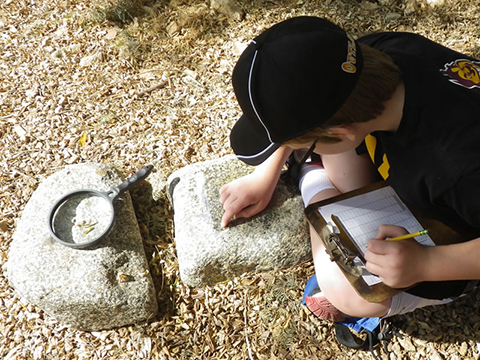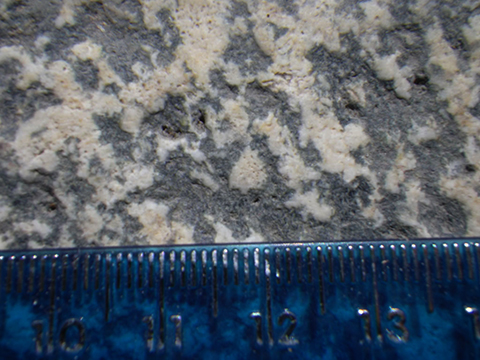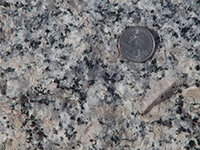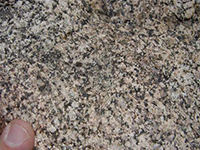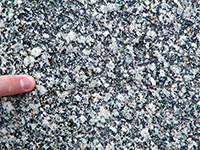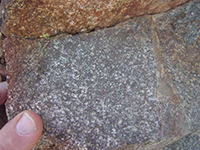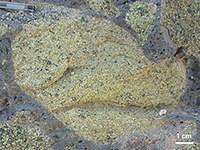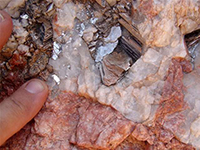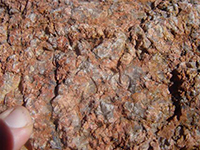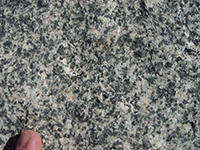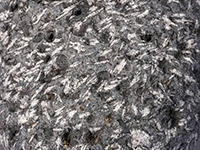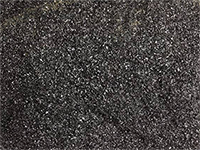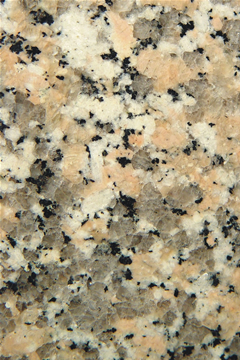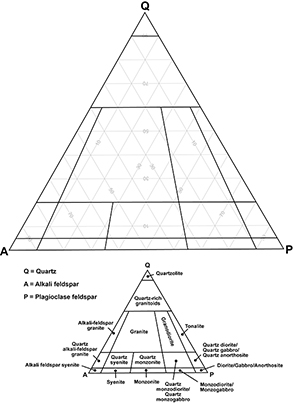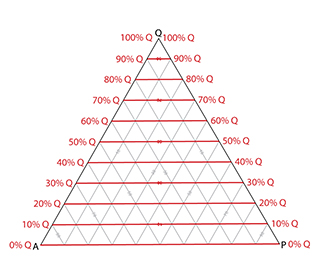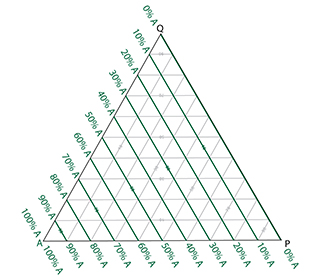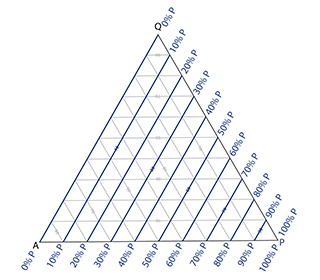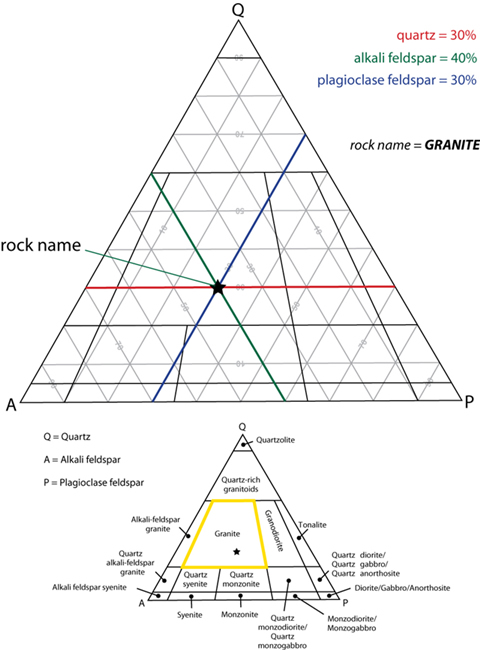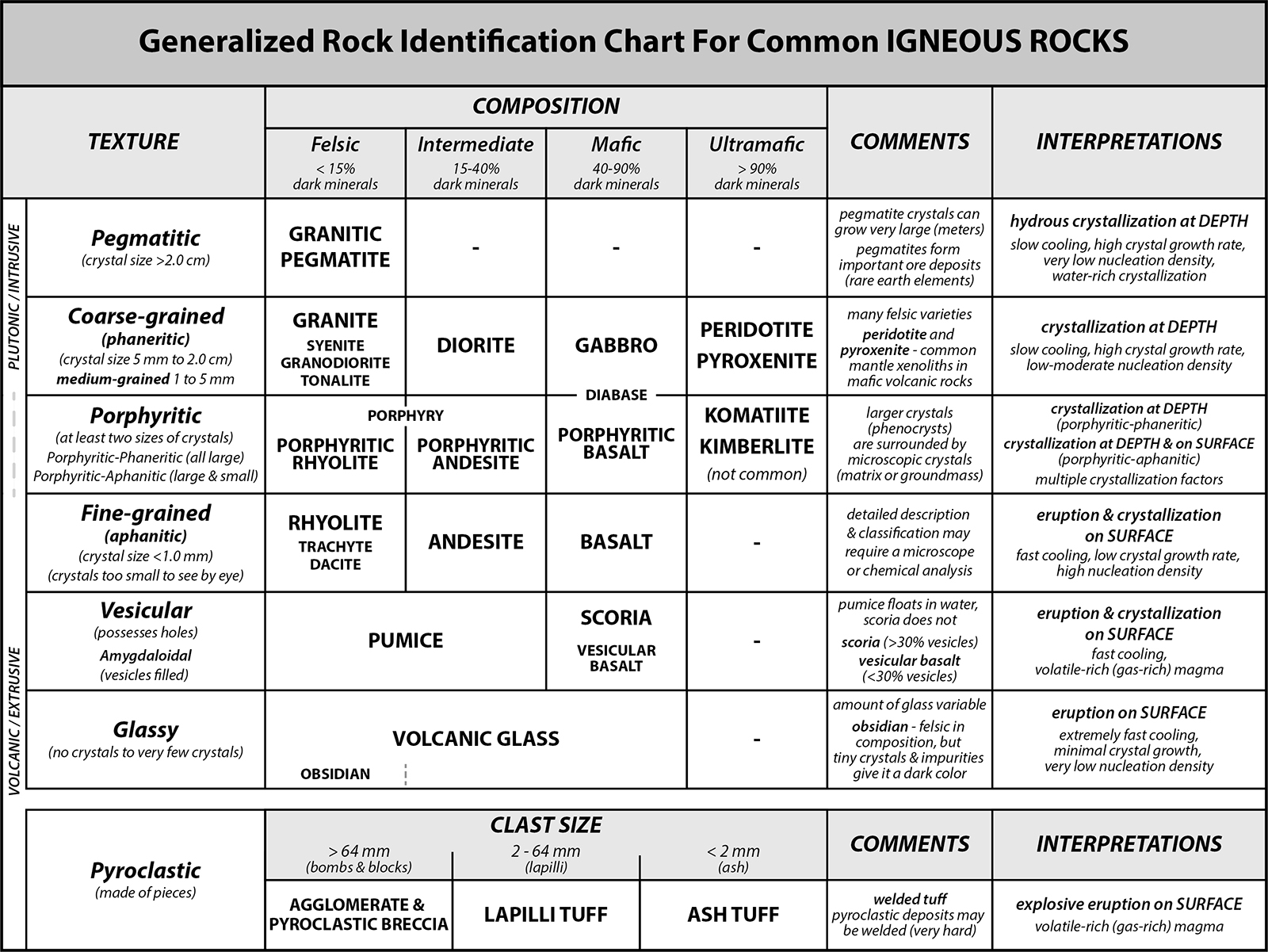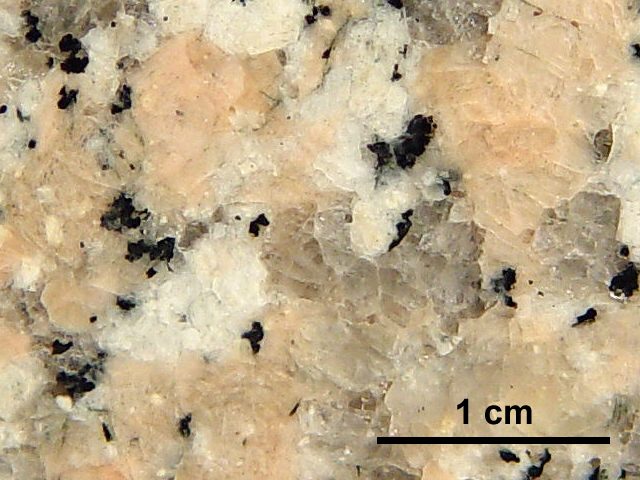Part B
Identifying & Interpreting Plutonic Rocks
There are a few different ways to classify plutonic igneous rocks. Most commonly, we make a reasoned, but somewhat subjective judgement of the size and arrangement of crystals/pieces (called texture) in a rock, combined with an estimate of the types and relative abundances of minerals present. This could be called a field classification, and is the kind of approach that we will typically use to identify most rocks in this course. While a field classification suffices for most of our needs, sometimes you just need to identify a rock with certainty. A more quantitative method combines observations of a rock's texture with the actual proportion of each minerals in the rock (called the mode). Modal analysis more accurately estimates a rock's name, but is rather time-consuming and is usually performed in the laboratory with a microscope. Additional chemical analysis and the determination of the abundances of certain elements (like Si, Fe, Mg, etc.) can be helpful, not only in classifying these rocks, but in describing their nature and origin. In this lab, you will learn how to identify plutonic rocks using both the field and modal classification methods.
Plutonic Rock Descriptions
There are many types of plutonic rocks, but most are some type of variation on the ones listed below. Here are some of the plutonic rocks that we will learn how to identify.
|
Granite |
Granodiorite |
Diorite |
Gabbro |
Peridotite (green nodules) |
|
Granitic pegmatite |
Alkali feldspar granite |
Tonalite |
Diabase |
Pyroxenite |
|
Figure 5-8. Common (and not so common) plutonic rock types. |
||||
> Light-colored, composed primarily of the minerals quartz (gray and glassy), alkali feldspar (peach-colored to white), and plagioclase feldspar (white to light gray), with minor amounts (<15%) of dark-colored biotite and amphibole.
> Color index <15 = felsic composition.
> Extremely common, with many compositional varieties.
> Leucogranite / alaskite - granitic rocks containing a very low amount of dark-colored minerals.
> Crystallizes from felsic magma that typically originates from melting of the continental crust.
> Forms intrusive bodies (plutons) of many sizes, from smaller dikes to larger batholiths. Aplite and pegmatite dikes are commonly rich in quartz, feldspar, and trace elements. Aplite is fine-grained, pegmatite is very coarse-grained.
> Plutonic equivalent of rhyolite.
> Arizona examples: Camelback Granite (Phoenix), Komatke Granite (South Mountain), Dells Granite (Prescott).
> Largely composed of amphibole (black) and plagioclase feldspar (white to gray) and has a higher abundance (15-40%) of dark-colored minerals than granite.
> Texture commonly referred to as "salt and pepper" because of its black and white appearance.
> Color index 15-40 = intermediate composition.
> Crystallizes from intermediate magma that commonly originates from hydrous (water-rich) subduction-related partial melting of oceanic and/or continental crust.
> Commonly associated with both felsic and mafic plutons.
> Plutonic equivalent of andesite.
> Arizona examples: Ruby pluton (Grand Canyon), Bland Quartz Diorite (central Arizona).
> Primarily composed of large amounts (40-90%) of pyroxene (black or very dark green) and plagioclase feldspar (gray), with lesser amounts of olivine (green and glassy).
> Color index 40-90 = mafic composition.
> Crystallizes from mafic magma derived from partial melting of the mantle.
> Forms much the oceanic crust.
> Plutonic equivalent of basalt.
> Arizona examples: Gibson Creek Complex (near Payson), many relatively small, unnamed bodies throughout the state.
> Composed of >90 % mafic minerals, mostly olivine (>40%) and pyroxene.
> Color index is >90 = ultramafic composition.
> Several sub-types exist, including lherzolite (40-90% olivine) and dunite (>90% olivine).
> Abundant in Earth's mantle and can partially melt to yield mafic magmas.
> Arizona examples: typically found as inclusions (xenoliths) in lava flows and intrusions around Arizona, including in the San Bernardino Valley and near San Carlos.
Other Plutonic Rock Types
There are many varieties of plutonic igneous rocks. Slight variations in the composition or texture necessitate additional rock terminology. A few important examples that we will use in this class are mentioned below.
> "Pegmatite" is a textural term, referring to a very coarse-grained plutonic rock with average crystal sizes >3 cm.
> Most pegmatites are felsic in composition and include quartz, alkali feldspar, muscovite, biotite, etc.
> May be enriched in economically valuable elements and minerals (rare earth elements, lithium, gemstones, etc.).
> Related to late-stage, water-rich crystallization of magma bodies.
> Arizona examples: abundant in the Hieroglyphic Mountains (central Arizona) and common in other areas where granitic plutons are exposed, like the Inner Gorge of the Grand Canyon.
> Granitic rock with little or no quartz and reddish to peach-colored alkali feldspar dominates over plagioclase.
> Plutonic equivalent of trachyte.
> Arizona examples: Gradational with granitic rocks in many areas.
> Granitic rock composed almost entirely of reddish to peach-colored alkali feldspar (40-80%) and quartz (20-60%) with very little plagioclase feldspar.
> Felsic in composition.
> Arizona examples: Granite of Bloody Basin (central Arizona).
> A very common rock type, similar to granite, but contains more plagioclase than potassium feldspar. It usually contains abundant biotite mica and hornblende, giving it a slightly higher color index and darker appearance than true granite.
> As the name implies, granodiorite lies between granite (felsic) and diorite (intermediate) in composition.
> The upper continental crust has the same average composition as granodiorite.
> Plutonic equivalent of dacite.
> Arizona examples: South Mountains Grandiorite (in Phoenix), Badger Spring Granodiorite (Cordes area), Brady Butte Granodiorite (Bradshaw Mountains).
> Similar to granodiorite in composition, with abundant plagioclase feldspar (40-80%) and quartz (20-60%), with <10% alkali feldspar. Also similar to diorite, but has >20% quartz.
> Felsic to intermediate in composition.
> Arizona examples: Cherry Tonalite (central Arizona), Government Canyon Tonalite (Bradshaw Mountains).
Diabase / Dolerite / Microgabbro![]()
> Similar in composition to gabbro, but more fine-grained with mostly plagioclase feldspar and pyroxene (no olivine).
> Mafic in composition.
> Forms from a faster rate of cooling in near-surface intrusions (dikes and sills) and lava flows.
> Arizona examples: Mesoproterozoic diabase forms sills and dikes in central Arizona and in the Grand Canyon.
> A rare plutonic rock composed mostly of plagioclase feldspar (>90%).
> Felsic in composition.
> Formed by crustal melting as plagioclase crystals floated to the top of a mafic magma chamber.
> Arizona examples: No known exposures. However, Apollo 15's "Genesis Rock" is anorthosite that likely composes much of lunar highlands.
> A pyroxene-rich ultramafic rock that has more pyroxene (>60%) than olivine.
> Several sub-types exist based on the amount of olivine and different types of pyroxene.
> Forms in several ways, including in the mantle or by crystal settling in a mafic magma chamber.
> Typically found as inclusions (xenoliths) in lava flows and intrusions.
> Arizona examples: nodules of pyroxenite can be found in some basaltic lava flows around Arizona, including in the San Bernadino Valley and near San Carlos.
Refer to the plutonic rock descriptions to answer Quiz Me! questions B06 through B10.
![]()
![]()
![]()
![]()
![]()
Using Mineralogy to Classify Plutonic Rocks
Since plutonic rocks have large crystals visible to the naked eye, we have only to identify the minerals and their relative abundances in the rock (called the mode).
Modal Classification
In 1973, the International Union of Geological Sciences (IUGS) Subcommission on the Systematics of Igneous Rocks (sounds seriously professional, doesn't it?) suggested the use of the modal composition for all plutonic igneous rocks with a color index <90. Modal analysis involves estimating the relative abundances of the minerals in a rock. Color index is the percentage of dark-colored minerals in a rock, so a C.I. <90 equates to felsic, intermediate, and mafic compositions. This classification schemes utilizes a ternary (3 component) diagram (see Figure 5-9).
|
|
|
Figure 5-9. The IUGS QAP ternary diagram for classifying felsic, intermediate, and mafic plutonic rocks (color index <90). |
How are modes calculated?
The relative percentages of the different minerals in a rock (modes) can be determined qualitiatively or quantitaively. The qualitative approach involves a visual estimate of the percentages of the different minerals, which is what we almost always do when we look at a rock and try to determine its composition. Another approach is more quantitative and involves methodically identifying and counting the mineral crystals using a grid, typically on a smooth rock slab or under a microscope (see Figure 5-10). This process yields accurate modal results, but is much more time-consuming. We will mostly rely on the former method in describing rock compositions in this class, but let's look at the point counting method a little more closely.
Let's use the rock in Figure 5-10 to show how modes for different minerals are determined.
|
Example 5 |
|
1) Determine the percentage of each mineral - Start by determining the percentage (the mode) of quartz (Q), alkali feldspar (A), plagioclase feldspar (P), and mafic minerals (M). This is done by identifying a counting the mineral crystals under a point-counting grid. For example, A1 = plagioclase feldspar, A2 = quartz, A3 = alkali feldspar, A4 = plagioclase feldspar, A5 = biotite, etc. |
|
The final mineral crystal count may look like this: Q = 40, A = 54, P = 41, M = 15, totalling 150 points. Accordingly, the percentages look like this: Q = 27% (40/150), A = 36% 54/150), P = 27% (41/150), and M = 10% (15/150). The modes should add up to 100, and M must be <90. |
|
2) Adjust the total and normalize to 100% - Subtract M from the total, then recalculate Q, A, and P so that their percentages add up to 100% (i.e., normalize Q, A, and P to 100%). |
|
M = 15, so 150 - 15 = 135. Q = 40, so to normalize to 100%, 40 / 135 = 30%. A = 54, so to normalize to 100%, 54 / 135. = 40%. P = 41, so to normalize to 100%, then 41/ 135 = 30%. |
How are the modes used to classify a rock?
The quartz, alkali feldspar, and plagioclase feldspar modes are used to determine the rock name by plotting them on the IUGS QAP ternary diagram for classifying felsic, intermediate, and mafic plutonic rocks (see Figure 5-11). This ternary (3-sided) diagram has quartz (Q), alkali feldspar (A), and plagioclase feldspar (P) at each corner.
The Q, A, and P modes for any given rock are then used to plot a point on the diagram, and thus yield the rock's name. The modes for quartz (Q), alkali feldspar (A), and plagioclase feldspar (P) are each plotted relative to their respective corners.
|
Figure 5-12. Understanding a ternary diagram. On a ternary diagram, values for Q = 100% in the Q corner, and become progressively lower away from the Q corner until they reach 0% at the opposite side of the triangle. The same relations are true for the A and P components. |
||
Let's plot the modes calculated in Example 5 on a QAP diagram and determine a name for this rock.
|
Example 6 |
|
1) Plot the mode for Q - To plot the percentage of quartz (30%), start at the side of the triangle opposite the Q corner (0% quartz) and move towards the Q apex until the 30%-line is reached. |
|
Draw a line on the ternary diagram along the 30% Q line (the red line). |
|
2) Plot the mode for A - To plot the percentage of alkali feldspar (40%), start at the side of the triangle opposite the A corner (0% alkali feldspar) and move towards the A apex until the 40%-line is reached. |
|
Draw a line on the ternary diagram along the 40% A line (the green line). |
|
3) Plot the mode for P - To plot the percentage of plagioclase feldspar (30%), start at the side of the triangle opposite thP A corner (0% plagioclase feldspar) and move towards the P apex until the 30%-line is reached. |
|
Draw a line on the ternary diagram along the 30% P line (the blue line). |
|
4) Determine the rock name - The field where the Q, A and P lines cross names the rock. Read its name from the field in the diagram key. |
|
All three lines intersect in the granite field, so the rock is granite |
Let's classify some more plutonic rocks using the QAP ternary diagram.
![]()
![]()
![]()
![]()
![]()
Another scheme is used for plutonic rocks with a color index >90 (i.e., ultramafic rocks). This ternary diagram (see Figure 5-13) has different mineral components (olivine and two types of pyroxene) than the QAP diagram, but it functions the same way.
|
|
|
Figure 5-13. The IUGS ternary diagram for classifying ultramafic plutonic rocks (color index >90). |
Use the ultramafic rock ternary diagram to answer Quiz Me! question B16 through B20.
![]()
![]()
![]()
![]()
![]()
Field Classification
A field classification is a fancy way of referring to how we typically observe and name most of the rocks that we encounter in our lives. For plutonic rocks, we first try to identify the texture (coarse-grained, porphyritic-phaneritic, etc.), which isn't terribly hard for plutonic rocks since there are only a few to choose from. Second, we evaluate the rock's composition (felsic, mafic, etc.). This can be done quickly by estimating a rock's color index (percentage of dark minerals in the rock). With practice, the types of minerals (quartz, biotite, etc.) and their relative abundances can be estimated to figure out a more precise composition. Knowledge of the texture and composition together yield the name of the plutonic rock and also allow us to make some general interpretations about how and where the rock formed. To summarize:
1) Identify the texture - Look at the average sizes of the crystals (1-5 mm = medium-grained, 5 mm to 3 cm = coarse-grained, >3 cm = pegmatitic) and their size distribution (all the same size = equigranular, different sizes = porphyritic).
Simple textural interpretations:
> coarse-grained - magma cools slowly at depth, allowing crystals to grow large.
> pegmatitic - water-rich magma cools slowly at depth, allowing crystals to grow very large.
> porphyritic - multiple cooling rates, possibly at depth and on/near the surface.
2) Identify the composition - Estimate the color index (% of dark-colored minerals) of the rock. Also try to identify the different minerals and their relative abundances (i.e., quartz = 10%, alkali feldspar = 50%, etc.).
Simple compositional interpretations:
> mafic magmas - generally produced by partially melting ultramafic mantle rocks (like peridotite).
> felsic magmas - typically form from melting crustal rocks.
|
Figure 5-14. A rock identification chart for common igneous rocks. Click HERE for a printable PDF version. |
* IMPORTANT *
Using the PDF link above, print a hard-copy version of this chart for use in this lab and the lab quiz.
|
Example 7 |
|
Name this plutonic rock. |
|
coarse-grained (phaneritic - crystals average several mm's in size, big enough to see easily), intermediate (<15% dark minerals) |
|
it's granite |
For Quiz Me! questions B21 through B30, refer to the igneous rock identification chart (Figure 5-14) and, if necessary, the discussion about texture and composition in Part A.
![]()
![]()
![]()
![]()
![]()
![]()
![]()
![]()
![]()
![]()
